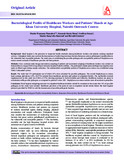| dc.contributor.author | Wamalwa, M. W. | |
| dc.contributor.author | Muna, Kennedy K. | |
| dc.contributor.author | Omuse, G. | |
| dc.contributor.author | Kamwati, S. K. | |
| dc.contributor.author | Revathi, G. | |
| dc.date.accessioned | 2021-04-09T13:01:05Z | |
| dc.date.available | 2021-04-09T13:01:05Z | |
| dc.date.issued | 2021-03 | |
| dc.identifier.citation | Annals of Pathology and Laboratory Medicine, Vol. 8, Issue 3, March, 2021 | en_US |
| dc.identifier.uri | https://www.pacificejournals.com/journal/index.php/apalm/article/view/3011 | |
| dc.identifier.uri | http://hdl.handle.net/123456789/4574 | |
| dc.description.abstract | Background: Hand hygiene is the precursor to improved health standards among healthcare workers and patients seeking outpatient services. Unhygienic hands may escalate the transmission of multi-drug resistance bacteria that poses serious pathological manifestation to the vulnerable and susceptible patients. The study aims at establishing the possible pathogen and susceptibility pattern of Staphylococcus aureus carried on hands of healthcare provider and their patients.
Methods: Cross sectional study design and random sampling of patients and convenient sampling of healthcare workers was carried out between May to August 2020 at Aga Khan University hospital Nairobi satellites. The participant’s hands palm and finger tips imprints were made on Blood agar during sample collection. The antimicrobial susceptibility pattern of Staphylococcus aureus was established using Vitek-2 automated system.
Result: The study had 374 participants out of which 14% were colonized by possible pathogens. The overall Staphylococcus aureus hand carriage prevalence 6.9% (26/374) isolated from healthcare provider and patient at outpatient facility. The methicillin resistant
staphylococcal in this study was 0.56% (2/374) showing resistance to both Oxacillin and Cefoxitin. Healthcare workers are prone to colonization with possible pathogens as compared to patient P-value .049. Staphylococcus aureus isolates were all resistant to penicillin.
Conclusion: Hand hygiene mitigating measures in outpatient healthcare facilities should be sustained on the counts that 14% of possible pathogens in this study were isolated. Healthcare providers at the point of care in outpatient should strictly follow the hand hygiene protocols provided by WHO to curb the transmission of possible pathogenic bacteria. | en_US |
| dc.language.iso | en | en_US |
| dc.subject | Bacteriological Profile, Susceptibility Pattern, Outpatient Point of Care, Healthcare Providers And Patients’ Hands | en_US |
| dc.title | Bacteriological Profile of Healthcare Workers and Patients’ Hands at Aga Khan University Hospital, Nairobi Outreach Centres | en_US |
| dc.type | Article | en_US |

